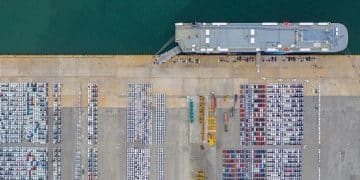Impact of 2025 Global Trade Slowdown on US Exports

The projected 2.3% global trade slowdown in 2025 is expected to negatively impact US exports due to reduced demand from key trade partners, increased competition, and potential disruptions to supply chains, necessitating strategic adjustments for US businesses.
The global economy is interconnected, and a slowdown in one area can have ripple effects worldwide. As projections indicate a 2.3% global trade slowdown in 2025, understanding how this will impact US exports becomes crucial for businesses and policymakers alike. This article will explore the potential consequences and offer insights into navigating these challenging times.
Understanding the Global Trade Slowdown in 2025
The forecasted 2.3% deceleration in global trade for 2025 raises concerns about its potential repercussions across various economies, particularly for nations heavily reliant on international commerce. This section aims to dissect the key factors contributing to this slowdown and examine the underlying trends that are shaping the global economic landscape.
Factors Contributing to the Slowdown
Several variables are converging to create a challenging environment for international trade. Understanding these factors is crucial for anticipating the potential impacts on US exports.
- Geopolitical Tensions: Ongoing conflicts and trade disputes between major economies contribute significantly to uncertainty and reduced trade flows.
- Inflationary Pressures: Persistent inflation in many countries is dampening consumer demand and affecting the affordability of imported goods.
- Supply Chain Disruptions: Lingering effects from past disruptions, coupled with new unforeseen events, continue to hamper the efficient movement of goods.
- Monetary Policy Tightening: Central banks raising interest rates to combat inflation can slow economic growth and reduce global trade volumes.
Consequently, businesses are facing increased costs and reduced demand, impacting their ability to export goods and services effectively.

In conclusion, the global trade slowdown in 2025 is a multifaceted issue influenced by geopolitical tensions, inflationary pressures, supply chain disruptions, and monetary policy tightening, each playing a vital role in shaping the international economic landscape.
The Direct Impact on US Exports
For the United States, a projected global trade slowdown spells noteworthy consequences for its export sector. This section delves into the immediate and tangible impacts that US exporters are likely to encounter, focusing on decreased demand, amplified competition, and potential supply chain vulnerabilities.
Decreased Demand from Key Trade Partners
A slowdown in global trade directly translates to lower demand for US goods and services from its major trade partners. Economic deceleration in these countries reduces their capacity and willingness to purchase American exports.
For example, if Europe experiences an economic downturn, demand for US agricultural products and manufactured goods would likely decline. Similarly, a slowdown in Asia could diminish the demand for US technology and machinery exports.
Increased Competition in Global Markets
With overall demand contracting, competition among exporting nations will intensify. US exporters will face pressure from companies in other countries vying for a smaller pool of customers.
This increased competition may lead to price wars, reduced profit margins, and difficulties in maintaining market share. US firms must innovate and differentiate their products to stay competitive in this environment.

In summary, the direct impact on US exports from a global trade slowdown encompasses diminished demand from crucial trade partners, heightened competition in global markets, and increased vulnerabilities within supply chains, all necessitating proactive measures for US businesses.
Industry-Specific Vulnerabilities
Different sectors within the US economy will experience varying degrees of impact from the projected trade deceleration. This segment spotlights some of the most vulnerable industries, dissecting particular challenges each sector could encounter.
Agriculture
The agricultural sector is highly dependent on exports. A decrease in global trade can significantly affect farmers and agricultural businesses.
For instance, reduced demand from countries like China and Mexico could lead to surpluses of crops and lower prices for US farmers. This could also affect related industries, such as food processing and transportation.
Manufacturing
The manufacturing sector, particularly those involved in heavy machinery and equipment, faces challenges due to reduced global investments and infrastructure projects. Below are key points:
- Decreased Demand for Capital Goods: As global economies slow, investments in infrastructure and new projects decrease, reducing demand for US-manufactured capital goods.
- Supply Chain Disruptions: Manufacturing relies on complex global supply chains, which can be disrupted by trade barriers and economic instability.
- Increased Production Costs: Rising costs of raw materials and labor can make US-manufactured goods less competitive in international markets.
These factors combine to create a difficult environment for US manufacturers who depend on exports.
In conclusion, while diverse sectors of the US economy face assorted repercussions from the projected trade deceleration, pinpointing specific vulnerabilities within industries such as agriculture and manufacturing is paramount for devising targeted strategies to mitigate adverse effects.
Strategies for US Businesses to Mitigate the Impact
Considering the looming trade slowdown, US businesses must adopt proactive strategies to safeguard their export activities. This section outlines key measures that companies can implement to mitigate potential adverse effects, focusing on diversification, innovation, and strategic partnerships.
Diversifying Export Markets
Relying on a limited number of export markets can be risky. Diversifying into new markets can reduce vulnerability to economic downturns in specific regions. Below are key points:
- Explore Untapped Markets: Identify and target countries with growing economies and increasing demand for US products.
- Adapt Products to Local Needs: Tailor products and services to meet the specific needs and preferences of different markets.
- Leverage Government Resources: Utilize export promotion programs and trade missions offered by the US government to explore new markets.
By diversifying, businesses can spread their risk and create more resilient export portfolios.
Investing in Innovation and Technology
Innovation is essential for maintaining competitiveness in global markets. Investing in research and development can lead to new products and processes that differentiate US exports.
Adopting new technologies can improve efficiency, reduce costs, and enhance product quality. This can help US businesses stay ahead of the competition and attract international customers.
In summary, for US businesses to effectively cushion the blow from an impending trade slowdown, the strategic diversification of export markets, coupled with investments in innovation and leveraging government support, are indispensable.
The Role of Government Policy
Government policies play a crucial role in supporting US exports during periods of global trade uncertainty. This part examines various policy tools and initiatives that can help mitigate the impact of the projected slowdown, underscoring the importance of trade agreements, export promotion, and regulatory adjustments.
Trade Agreements and Negotiations
Trade agreements can reduce barriers to exports and create more favorable conditions for US businesses. Actively pursuing and maintaining these pacts is vital.
Negotiating new agreements that open up new markets and address trade imbalances can significantly boost US exports. Additionally, enforcing existing agreements ensures that other countries adhere to their commitments.
Export Promotion and Support Programs
Government agencies can provide valuable support to US exporters through various promotion and support programs.
These programs can include financial assistance, market research, trade missions, and export counseling. Increased funding and resources for these initiatives can help US businesses expand their international reach.
Ultimately, government policies designed to bolster US exports amid global trade turbulence are crucial, with trade agreements, export promotion, and regulatory amendments serving as essential pillars.
Long-Term Implications for the US Economy
The projected global trade slowdown could have far-reaching and long-lasting effects on the US economy. This segment explores the potential long-term implications, including impacts on employment, economic growth, and the overall competitiveness of the United States in the international arena.
Impact on Employment
A decline in exports can lead to job losses in export-oriented industries. Reduced demand for US products overseas can force companies to cut production and lay off workers.
However, investing in innovation and diversifying into new markets can create new jobs and offset some of these losses. Government policies that support worker retraining and skills development can also help mitigate the employment impact.
Effects on Economic Growth
Exports are a significant driver of economic growth in the United States. A slowdown in global trade can dampen economic activity and slow down GDP growth.
However, domestic demand and government spending can help offset the impact of reduced exports. Stimulus measures and infrastructure investments can boost economic growth and create new opportunities for businesses.
In essence, the prolonged repercussions of a global trade deceleration on the US economy are profound, potentially influencing employment rates, overall competitiveness, and economic growth trajectories significantly.
| Key Highlight | Brief Description |
|---|---|
| 📉 Trade Slowdown | Global trade is projected to slow by 2.3% in 2025. |
| 🇺🇸 Impact on US Exports | US exports face decreased demand and increased competition. |
| 🌱 Agriculture Sector | Farmers may face surplus crops and lower prices. |
| 💡 Mitigation Strategies | Diversify markets, innovate, and leverage government support. |
Frequently Asked Questions
▼
The slowdown is attributed to factors like geopolitical tensions, inflationary pressures, supply chain disruptions, and monetary policy tightening by central banks worldwide.
▼
US businesses can expect reduced demand for exports, increased competition in global markets, and potential vulnerabilities in their supply chains.
▼
Sectors like agriculture, manufacturing, and industries heavily reliant on international trade are particularly vulnerable to the projected slowdown.
▼
Businesses can diversify export markets, invest in innovation and technology, and leverage available government support programs and resources.
▼
The government can negotiate trade agreements, promote exports through support programs, and adjust regulations to create a more favorable environment for US exporters.
Conclusion
In conclusion, the projected 2.3% global trade slowdown in 2025 poses significant challenges for US exports. Understanding the causes and potential impacts is essential for businesses and policymakers to develop effective mitigation strategies, ensuring the continued competitiveness and resilience of the US economy in the face of global economic headwinds.





